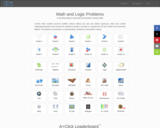
This site offers math and logic problems for ages 5 and up to adult.
- Subject:
- Math
- Material Type:
- Activity/Lab
- Game
- Homework/Assignment
- Author:
- Aplusclick
- Igor Kokcharov
- Date Added:
- 03/27/2020

This site offers math and logic problems for ages 5 and up to adult.
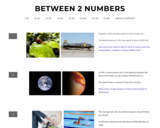
The inspiration for this site came from John Allen Paulos' book Innumeracy. From it Fawn Nguyen took the mathematical fun facts, etc. and created middle school mathematics critical thinking problems that relate to ratios and proportional reasoning and require students to compare stuff and really get them thinking.
Here's an example:
Tortoises have the longest lifespan among vertebrates, about 200 years.
A fruit fly's lifespan is about 45 days.
If we scaled both lifespans down so that a tortoise's 200 years is now 1 day, then what is the fruit fly's lifespan, in seconds?
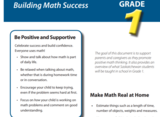
A series of pamphlets has been developed with the goal of supporting parents and caregivers as they promote positive math thinking in the home. The printable pamphlets, developed in collaboration with sector partners, also provide an overview of what students will be taught in school in each of grades 1-9, based on Saskatchewan curricula.
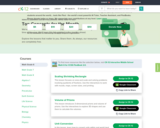
Excellent Interactive Lessons AND Assessments for All Levels of Math for Teachers and Students

Get your students coding in no time!
CodeMonkey is a fun and educational game-based environment where kids learn to code without any prior experience. After completing CodeMonkey's award-winning coding courses, kids will be able to navigate through the programming world with a sense of confidence and accomplishment.
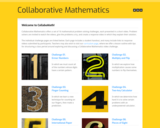
This website has various video challenges with accompanying PDF's for student use . Students are able to post their own videos of how they solved the challenge, and take a look at how others solved it as well.
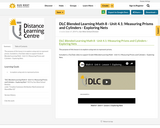
The purpose of this lesson is to explore using nets to represent prisms.
Included is a YouTube video to support Grade 8 Blended Learning Math - Unit 4.1: Measuring Prisms and Cylinders - Exploring Nets.
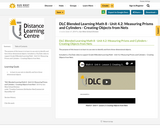
The purpose of this lesson is to learn to use nets to identify and form three-dimensional objects.
Included is a YouTube video to support Grade 8 Blended Learning Math - Unit 4.2: Measuring Prisms and Cylinders - Creating Objects from Nets.
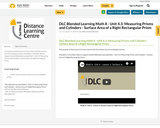
The purpose of this lesson is to learn how to find the surface area of rectangular prisms.
Included is a YouTube video to support Grade 8 Blended Learning Math - Unit 4.3: Measuring Prisms and Cylinders - Surface Area of a Right Rectangular Prism.
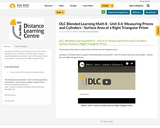
The purpose of this lesson is to learn how to find the area of triangular prisms.
Included is a YouTube video to support Grade 8 Blended Learning Math - Unit 4.4: Measuring Prisms and Cylinders - Surface Area of a Right Triangular Prism..
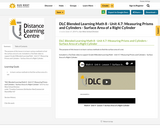
The purpose of this lesson is to learn various methods to find the surface area of a net.
Included is a YouTube video to support Grade 8 Blended Learning Math - Unit 4.7: Measuring Prisms and Cylinders - Surface Area of a Right Cylinder.
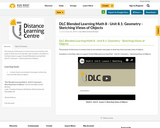
The purpose of this lesson is to learn how to use isometric dot paper to draw top, front and side views of objects.
Included is a YouTube video to support Grade 8 Blended Learning Math - Unit 8.1: Geometry - Sketching Views of Objects.
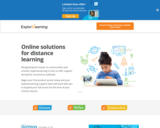
Explore Learning offers 3 programs to support students learning at home:
Gizmos (Grades 3-12) Get hands-on with math and science.
Gizmos are online simulations that excite curiosity and invite interaction. We’ve got over 400 Gizmos in our library covering topics and concepts in math and science for grades 3-12. Gizmos help students dig deeper into subjects and really understand challenging concepts.
Reflex (Grades 2-6) When they use Reflex, kids love math.
Adaptive and individualized, Reflex is the most effective system for mastering basic math facts in addition, subtraction, multiplication and division.
Full of games that students love, Reflex takes students at every level and helps them quickly gain math fact fluency and confidence. And educators and parents love the powerful reporting that allows them to monitor progress and celebrate success.
Science4Us (Grades K-2) It’s never too early to learn science!
Science4Us covers Inquiry, Physical Science, Life Science and Earth & Space Science with lessons specifically designed for K-2 students. The sessions have 1000’s of online and offline activities that can be completed in as little as ten minutes, and teach students using videos, interaction, poems, songs, and digital notebooks.

A lesson using Farm 360 Virtual Tour and linking it to Science and Careers. The students will move around a 360 video to experience life on a farm or orchard. It outlines production and importance of the industry. There is an ELA writing component at the end of the lesson to be handed in.
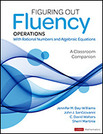
This site offers 4 free math activities to assist students with increasing their fluency in operations with rational number and algebraic equations. The activities include:
Activity 7.7: "Would You Rather..." Routine
There are two versions of this routine with systems of linear equations—choosing different strategies (e.g., Use Tables or Use Graphs) and making choices within a strategy (e.g., For which variable will I substitute? Or Which variables will I eliminate?).
Activity 6.10: The Transformer Game
This game is a fun way to give students opportunities to choose and use different basic transformations to start solving equations.
Activity 5.7: Worked Examples For Ratios and Proportions
Use this activity for worked examples for ratios and proportions. Correctly worked examples and partially solved worked examples benefit students so that they can understand strategy.
ACTIVITY 4.11: Quotient Connect Game
This game is an engaging way to practice division using Partial Quotients. It is played similarly to the classic board game Boggle as students find quotients through connected digits.

Give a 5 question mixed review quiz to students every Friday.The questions can focus on current learning, but should also include questions from the entire year (especially concepts needed for next week's lessons, or foundational items that need to be mastered). This strategy will help develop mastery, provide opportunities for mixed practice to ensure comprehension beyond specific learning content.

MathScore helps students acquire a deep understanding of math by providing adaptive math practice that functions like self-guided lessons. MathScore is fun and improves math confidence and grittiness. For any important math concept, we help students achieve mastery in 3 phases:
1. Develop relatable, definition-level understanding:
2. Develop computational excellence: Using adaptive techniques, we efficiently develop strong computational skills.
3. Develop analytical understanding.

The National Hockey League (NHL) and the National Hockey League Players’ Association (NHLPA) have partnered to launch the Future Goals program, a North-American initiative that provides K-12 students with STEM education. EVERFI’s Hockey Scholar course, with both a math and science edition, leverages highly interactive gameplay and the sport of hockey to reinforce key concepts like scientific thinking and data analysis, exposing students to foundational STEM concepts through real-life applications.
This Course Covers Foundational STEM Concepts Scientific Thinking,Data/Graphical Analysis
Uncover The Ice - Students derive area formula and proper units of measurement to calculate the area of each section of ice as they remove covering.
Area, units, unit square, square meters, formula 4 SS4.2 5 SS5.1-4 6 SS6.2 7 SS7.2 8 SS8.2-3
Paint The Ice - Students apply knowledge of geometric figures and coordinate planes to paint the ice rink. Point, coordinate, x/y-axis, line, chord, segment, parallel, right angle, congruent perpendicular, diameter, radius5 SS5.5 6 SS6.3-47 SS7.1-5
The Pass - Students measure and find patterns between angles lying on a straight line, by setting up a pass that bounces off the boards and discover the Law of Reflection based on their data. Protractor, degrees, right angle, straight angles, Law of Reflection, adjacent angles 6 SS6.1, SS6.3 7 SS7.1, SS7.3 8 OP8.1
The Shot - Students explore the interaction between applied force and frictional force and use this knowledge to hit specific targets on the ice.
Force, magnitude, direction, friction, Newton’s 1st Law 5 FM5.1-3 6 FL6.2
Speed - Students record and calculate a player’s average speed (using d = v/t formula) over short and long sprint distances Rate, units of distance (m, km, mi), trials, average, rounding, formula 5 SP5.3 6 SP6.1, N6.8 7 SP7.1-2 8 P8.1, N8.3
The Skate Blades - Students help players stop on a certain target based on the radius of hollow of their skate blades, and use this data to figure out the correlation between radius of hollow and stopping distance. Variables, radius, correlation 5 P5.1, FM5.1 6 P6.1, P6.3, FL6.3 7 P7.1, SS7.2, SP7.2 8 P8.1
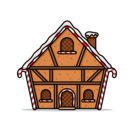
Cross curricular unit plan.

Illuminations works to serve you by increasing access to quality standards-based resources for teaching and learning mathematics, including interactive tools for students and instructional support for teachers.
The website includes:
- Lesson plans
- Online math strategy games against a computer or other players across the world
- Activities
-